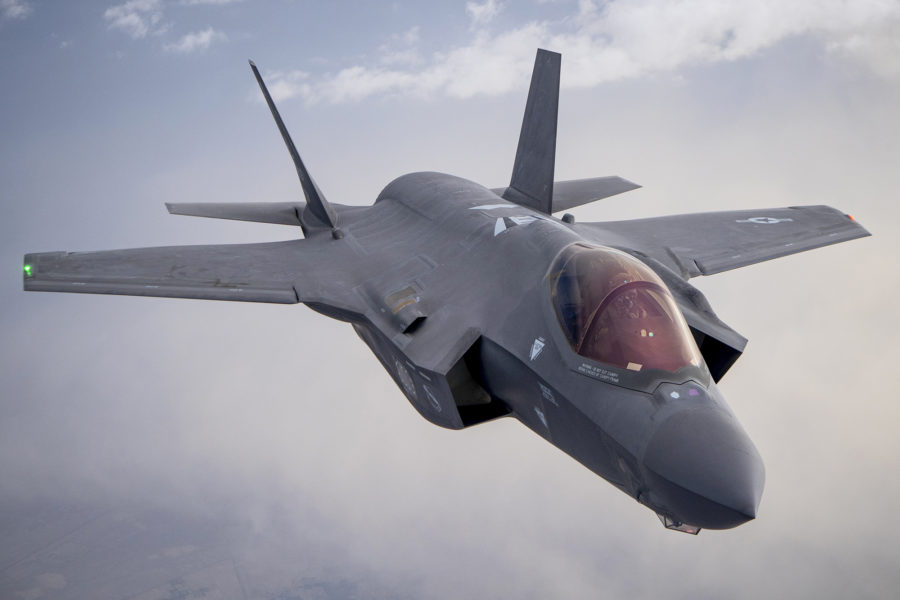The 97 F-35s added to service budgets over the last five years are a “self-inflicted wound,” as they have played havoc with sustainment, House Armed Services Committee tactical air and land forces and readiness panel leaders said in a joint April 22 hearing. They vowed not to compound the problem by adding extra jets beyond the services’ requests in the fiscal 2022 budget, and perhaps not thereafter.
“I can assure you that this year, if anybody suggests a plus-up” of service requests for F-35 fighters, “there will be one hell of a fight, and I don’t propose to lose it,” said Rep. John Garamendi (D-Calif.), chair of the readiness subcommittee, who offered similar warnings at a recent hearing of his own subcommittee. Garamendi said he has “allies” in his thinking.
Tac Air chairman Rep. Donald Norcross (D-N.J.) voiced the committee’s concern that sustainment of the F-35 is far exceeding what the services have budgeted, and it’s “unaffordable” in the case of the Air Force.
The problem could “result in a 47 percent reduction in the Air Force planned inventory goal of 1,763 aircraft, just to remain in their budget,” Norcross said.
If the program “continues to fail to significantly control and reduce” sustainment costs, “we may need to invest in other, more affordable programs, and backfill an operational shortfall of potentially over 800 fighters.” Norcross noted that “we don’t have unlimited resources” and that he “would not support any request for additional aircraft beyond what is contained in this year’s President’s Budget request.”
In recent years, the Air Force has requested 48 F-35s a year, but Congress has upped that to 60. Witnesses in the hearing said the additional aircraft strained the repair, sustainment, and depot system with unplanned volume, and also challenged parts and materials vendors to meet the demands of both production and maintenance.
Garamendi drew a breath and said, “I’m going to … try to contain my anger at what is going on here.” The F-35 is “over budget, fails to deliver on promised capabilities, [and] mission capability rates do not even begin to meet the service threshholds.”
He warned witnesses, “the easy days of the past are over.” The “industry solution” of asking taxpayers “to throw money at the problem … will not happen.” He vowed that the F-35’s sustainment issues will be addressed and “resolved in this committee, this year.” Witnesses included Gregory M. Ulmer, Lockheed Martin vice president for aeronautics; Matthew F. Bromberg, president of Pratt & Whitney military engines; Joint Program Office Director Lt. Gen. Eric T. Fick; Air Force F-35 Integration Office Director Brig. Gen. David W. Abba, and the Government Accountability Office’s Diana Maurer, director of military structure and operations issues.
Asked to estimate the additional costs of the extra jets, Fick said “100 extra aircraft, at 250 hours [per year is] 25,000 extra hours,” at a cost, in today’s dollars, of over $41,000 per hour.
“That is added sustainment cost being borne by the services that they otherwise wouldn’t have to bear,” he said. This has “hurt us from a supply perspective.”
Maurer put the 47 percent overage in context:
“If, starting tomorrow, Lockheed Martin and Pratt & Whitney announced that all spare parts would be free for the rest of the program, that still would not be sufficient to close the gap” in sustainment costs. “Bottom line, …the services have a plane they cannot afford to fly; at least not in the way they want to fly it, long term.”
There are three possible ways forward, she said.
- “Squeeze more cost savings” out of the program, which she said would be difficult because the structure of fees, sustainability rates, and other measures are “baked in,” and were based on optimistic thinking 20 years ago.
- “Take a hard look at requirements” in terms of flying hours, readiness, and the number of aircraft to be bought. These are “significant tradeoffs,” she allowed, adding that GAO does not have a position on any of those tradeoffs.
- “Simply … spend more.” The sustainment targets were set by the services, and they can change them, she said. But that could potentially cost “billions more. That could potentially crowd out other priorities.” She advised Congress to “pay close attention to how the program is closing these capability gaps when you decide how many new aircraft to purchase.”
Ulmer noted that Lockheed and the JPO have pushed to open 60 depots by 2030. Although that will help with repair and rework, it also has taxed the availability of spares and trained maintainers because they are spread out over a greater number of locations.
“This is at the heart of why we have a supply problem,” Fick observed. “We also had a couple of years were we didn’t buy any spares, and that hurt us, too.”
As production hits peak, and “as we crest that wave, and we’re leveling out, we’ve proven we can make” the ordered number of aircraft. “We just need to settle at that rate, allow the system to recover, deliver the parts that we need, follow through with our commitments to stand up the organic depots inside the U.S. and [overseas], that will help us from a global capacity perspective to fill out the solution around the world.”
Garamendi slightly softened his tone at the end of the hearing, thanking the managers for their efforts and saying, “We’re all in this together.”

